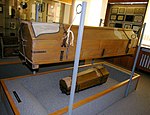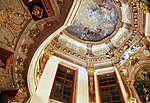Wien Südbahnhof
Buildings and structures in FavoritenRailway stations in Austria closed in 2009Railway stations in Austria opened in 1841Railway stations in Austria opened in the 19th centuryRailway stations in Vienna

Wien Südbahnhof (German for Vienna South Station) was Vienna's largest railway terminus. It closed in December 2009 and was demolished in 2010 to be replaced with a new station, Wien Hauptbahnhof. It was located in Favoriten, in the south-east of the city. The East-bound rail services of Südbahnhof remained in operation until 2012 at a temporary train station "Südbahnhof (Ostbahn)".
Excerpt from the Wikipedia article Wien Südbahnhof (License: CC BY-SA 3.0, Authors, Images).Wien Südbahnhof
Karl-Popper-Straße, Vienna KG Favoriten (Favoriten)
Geographical coordinates (GPS) Address Nearby Places Show on map
Geographical coordinates (GPS)
| Latitude | Longitude |
|---|---|
| N 48.186667 ° | E 16.38 ° |
Address
Karl-Popper-Straße
Karl-Popper-Straße
1100 Vienna, KG Favoriten (Favoriten)
Austria
Open on Google Maps











